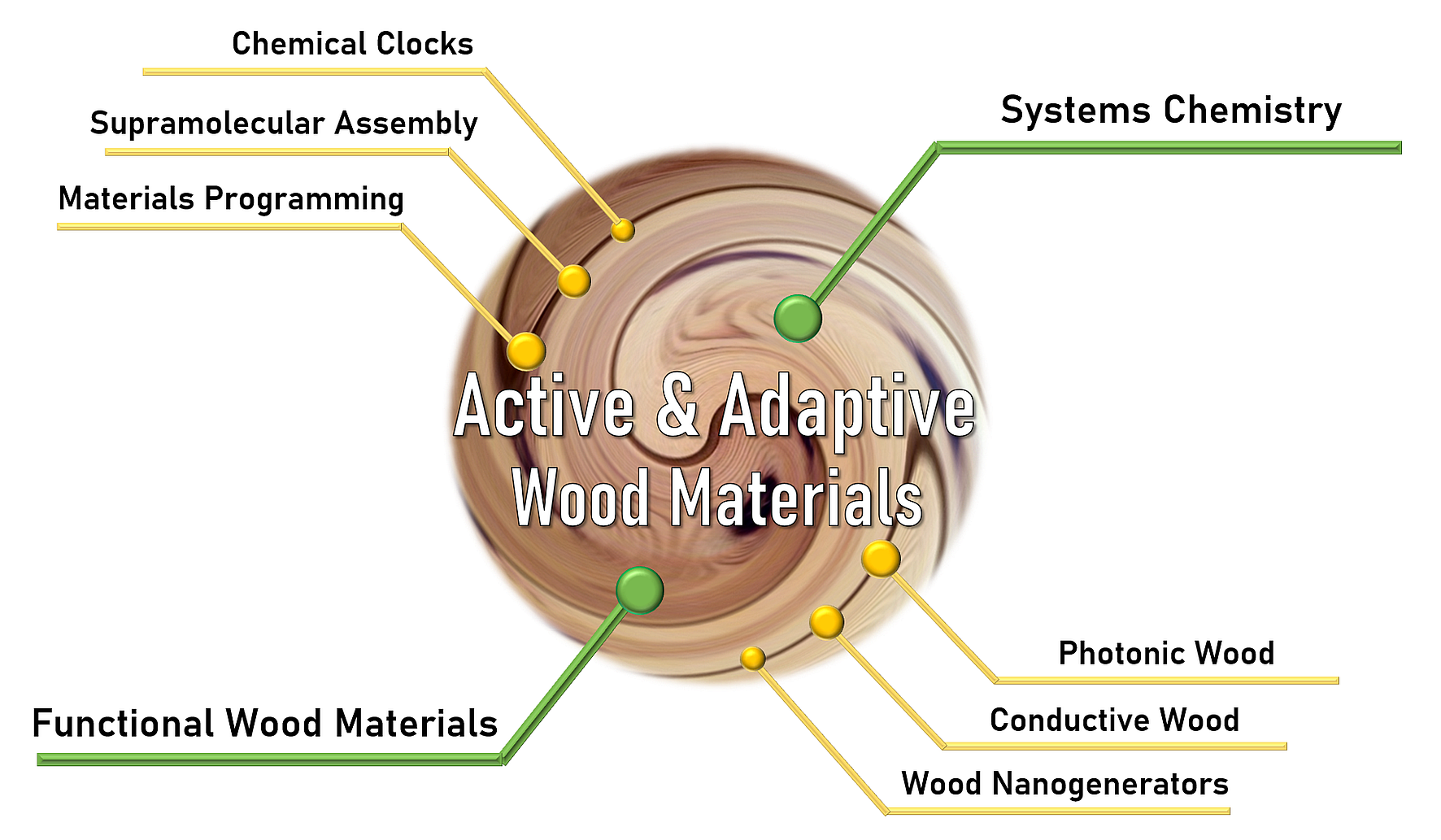Active and Adaptive Wood Materials - Dr. Guido Panzarasa
From vial to veneer, from bench to building
Mission
The increasing demand for sustainable building materials with advanced properties calls for the development of novel wood materials. In the Active and Adaptive Wood Materials group we address these fundamental challenges by pushing the boundaries of wood science and technology. We combine state-of-art wood modification methods with a unique philosophy mutuated from supramolecular and systems chemistry. We take advantage of the amazing variety of structures and compositions of different wood species to enable wood with new properties (“smart wood”) for the benefit of both the built and natural environment.
Research Highlights
Chemically Programmable Wood Materials
Materials can be programmed to change their properties upon the application of certain stimuli, even without the need of external trigger events. This can be achieved by embedding control systems, such as chemical clocks, in the material structure itself. Enabling wood with chemical time-programmability could result in materials with unprecedented behavior, and exciting applications e.g. as smart actuators for soft robotics.
Wood Materials for Energy and Sustainability
Natural evolution enabled wood with excellent mechanical properties originating from a complex, multiscale hierarchical organization. Thanks also to its strength and durability, wood is used since ancient times as a versatile, intrinsically sustainable building material. However, the properties of native wood are not as optimal when it comes, for example, to electrical conductivity, or visible light propagation.
State-of-art electronics and photonics are not sustainable, as they often require the use of rare chemical elements and of non-biodegradable, even toxic, materials that, when dispersed in the environment, become sources of pollution with global repercussions. Reducing the amount of electronic waste (e-waste) requires to substitute conventional materials with much “greener” ones. Making electronic and photonic devices with wood is an exciting challenge. Such devices could be incorporated in smart buildings as built-in sensors, controllers and optical elements. Eventually, at the end of their lifecycle, they could be disposed as harmless biodegradable waste, closing the cycle: from the tree to the device, to another tree.
Wood Nanogenerators (Jianguo Sun)
Harvesting the mechanical energy generated by occupants, as they live and work in buildings, by means of piezo- and triboelectric nanogenerators, has recently become an attractive way to increase the energy efficiency of smart buildings. Nevertheless, due to the poor intrisinc piezo- and triboelectric properties of native wood, very limited effort has been devoted towards the design of wood and wood-based nanogenerators. We aim to fill this gap, improving the piezo- and triboelectric properties of wood without sacrificing its sustainability, eventually developing biodegradable energy harvesting devices.
Wood-MOF Hybrid Composites (Kunkun Tu)
Metal–organic frameworks (MOFs) are one-, two-, or three-dimensional coordination networks formed by metal ions and organic ligands. Thanks to their ease of synthesis and tailorable porosity, MOFs are of great interest for a variety of applications, from the storage of gases such as water and carbon dioxide to catalysis and energy harvesting. By growing MOF nanocrystals within wood substrates, advanced composite materials with enhanced mechanical properties are obtained. Compared to conventional polymer substrates, the resulting wood-MOF hybrids have superior mechanical properties, without affecting the functionality of MOFs.
Functional Wood Membranes (Yong Ding)
Self-regulating materials that can adapt and respond to environmental changes have great potential for reducing the energy consumption of buildings. Using wood as a scaffold to develop functional membranes it is possible to take advantage of its intrinsic hierarchical structure as well as its mechanical stability. Janus wood membranes for autonomous and directional liquid transport, atmospheric water harvesting, and autonomous thermal regulation can be obtained by embedding thermo-responsive polymeric hydrogels and metal-organic frameworks (MOFs) into wood scaffolds. These hybrid materials with tailored functionalities could help meet the needs of future smart buildings.
Electrically Conductive Wood (Christopher Dreimol)
Common knowledge takes wood for an electrical insulator, and for some applications this could be even positive. However, enabling wood with electrical conductivity will open a wide range of unprecedented applications for such a strategic building material. Towards this goal, we study the effect of combined laser and chemical treatments on the surface of wood, finding the right conditions that lead to highly conductive laser-induced graphene structures. As a result, sustainable structural wood panels with built-in sensors could be produced on a large scale, ready to become active part of next-generation smart buildings.
Photonic Wood (Maximilian Ritter)
The optical properties of native wood are rather poor. Nevertheless, the study of wood-light interaction are especially promising for the development of e.g. photothermal, photochromic devices. The propagation of visible light inside wood can be improved by a combination of strategies, including refractive index matching with suitable polymers (“transparent wood”). The resulting composites, however, are most often non-biodegradable. Selective chemical modification, or removal, of lignin can improve the optical properties of wood without compromising its intrinsic sustainability.

